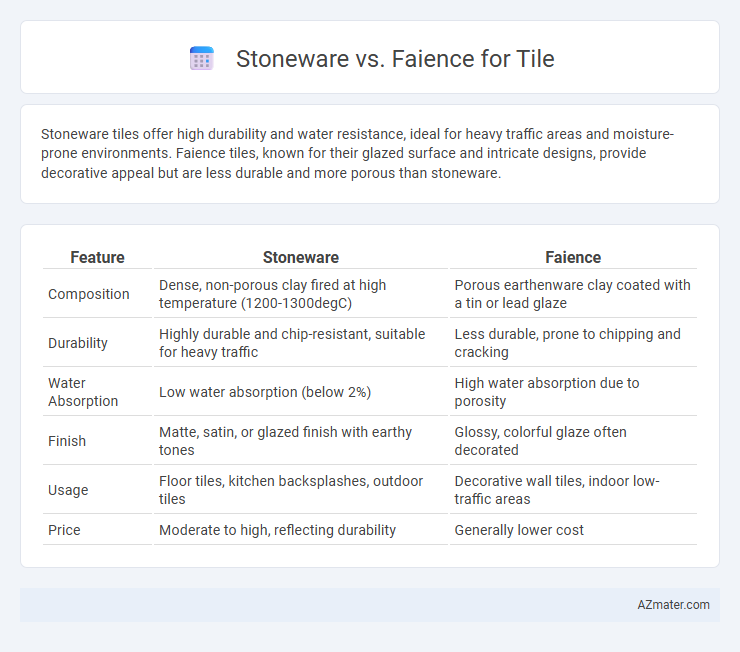Stoneware tiles offer high durability and water resistance, ideal for heavy traffic areas and moisture-prone environments. Faience tiles, known for their glazed surface and intricate designs, provide decorative appeal but are less durable and more porous than stoneware.
Table of Comparison
| Feature | Stoneware | Faience |
|---|---|---|
| Composition | Dense, non-porous clay fired at high temperature (1200-1300degC) | Porous earthenware clay coated with a tin or lead glaze |
| Durability | Highly durable and chip-resistant, suitable for heavy traffic | Less durable, prone to chipping and cracking |
| Water Absorption | Low water absorption (below 2%) | High water absorption due to porosity |
| Finish | Matte, satin, or glazed finish with earthy tones | Glossy, colorful glaze often decorated |
| Usage | Floor tiles, kitchen backsplashes, outdoor tiles | Decorative wall tiles, indoor low-traffic areas |
| Price | Moderate to high, reflecting durability | Generally lower cost |
Introduction to Stoneware and Faience Tiles
Stoneware tiles are made from dense, vitrified clay fired at high temperatures, resulting in a durable and water-resistant surface ideal for high-traffic areas. Faience tiles, crafted from a fine tin-glazed ceramic, offer vibrant colors and intricate designs but are more porous and suited for decorative indoor applications. Understanding the material composition and intended use of stoneware and faience tiles is essential for selecting the right tile for both aesthetic appeal and functional performance.
Defining Stoneware: Properties and Composition
Stoneware tiles are crafted from dense, non-porous clay fired at high temperatures between 1,200degC and 1,300degC, resulting in a durable and water-resistant material ideal for both indoor and outdoor use. Their composition includes a mixture of natural clays and minerals that vitrify during firing, giving stoneware its characteristic strength, hardness, and resistance to scratches and stains. This robust composition makes stoneware tiles highly suitable for high-traffic areas, offering longevity and minimal maintenance compared to more porous materials like faience.
Understanding Faience: Characteristics and Origins
Faience tile, originating from ancient Egypt and later popularized in the Mediterranean, is known for its glazed, tin-based surface that produces a bright, opaque finish ideal for decorative applications. Unlike stoneware, which is a dense, vitrified ceramic fired at high temperatures for durability, faience is more porous and often less resistant to wear, making it suitable primarily for indoor use and decorative purposes. Its characteristic vibrant colors and intricate designs result from the unique glazing process that incorporates metallic oxides, distinguishing it from the earthy tones and robust texture of stoneware tiles.
Durability Comparison: Stoneware vs Faience
Stoneware tiles exhibit superior durability due to their dense, vitrified composition, making them highly resistant to chipping, cracking, and moisture penetration compared to faience tiles. Faience tiles, crafted from a porous earthenware clay and featuring a glazed surface, are more prone to wear and damage under heavy foot traffic or exposure to harsh environments. The robust nature of stoneware makes it a preferred choice for high-traffic and outdoor applications, whereas faience suits decorative, low-impact settings where durability is less critical.
Water Absorption and Porosity Levels
Stoneware tiles exhibit low porosity and water absorption rates typically below 0.5%, making them highly resistant to moisture and ideal for wet environments. Faience tiles possess higher porosity, with water absorption rates ranging from 5% to 15%, which can lead to increased susceptibility to water damage and staining. The dense composition of stoneware ensures superior durability and reduced maintenance compared to the more porous and fragile faience.
Design and Color Options for Stoneware and Faience
Stoneware tiles offer a broad palette of natural earth tones with subtle texture variations, lending a rustic yet modern aesthetic ideal for spaces requiring durable, understated elegance. Faience tiles are known for their vibrant, glossy finishes and intricate hand-painted designs, providing bold color options and decorative patterns that bring a lively, artistic flair to walls and surfaces. Choosing between stoneware and faience depends on the desired design impact: stoneware for muted, durable surfaces and faience for colorful, ornamental statements.
Ideal Applications: Choosing the Right Tile for Your Project
Stoneware tiles, known for their durability and water resistance, are ideal for high-traffic areas such as kitchens, bathrooms, and outdoor patios due to their dense, non-porous composition. Faience tiles, with their vibrant colors and glazed surfaces, excel in decorative applications like backsplashes, feature walls, and low-moisture environments where aesthetic appeal takes precedence. Selecting between stoneware and faience depends on balancing functional needs, such as wear resistance, with design goals, ensuring optimal performance and visual impact for each project.
Maintenance and Cleaning Differences
Stoneware tiles offer superior durability and resistance to stains, requiring minimal maintenance with regular sweeping and occasional mopping using pH-neutral cleaners. Faience tiles, made from glazed earthenware, are more porous and prone to chipping, necessitating gentle cleaning methods with non-abrasive, mild detergents to preserve their intricate glazes. Proper sealing of stoneware enhances its ease of cleaning, while faience benefits from careful handling to avoid damage during maintenance.
Cost Analysis: Stoneware versus Faience
Stoneware tiles typically cost more than faience tiles due to their higher durability and denser composition, which require more energy-intensive firing processes. Faience tiles offer a more budget-friendly option ideal for decorative installations, although they may incur additional maintenance costs over time because of their porous nature. Cost considerations should balance initial investment against long-term performance, especially in high-traffic or moisture-exposed areas where stoneware's resilience provides greater value.
Conclusion: Which Tile is Best for Your Needs?
Stoneware tiles offer superior durability, water resistance, and suitability for high-traffic areas, making them ideal for kitchens, bathrooms, and outdoor applications. Faience tiles excel in decorative appeal with intricate glazed designs but are less resilient and better suited for low-traffic, aesthetic-focused spaces. Choosing between stoneware and faience depends on prioritizing functional durability versus artistic expression for your tile needs.

Infographic: Stoneware vs Faience for Tile
 azmater.com
azmater.com